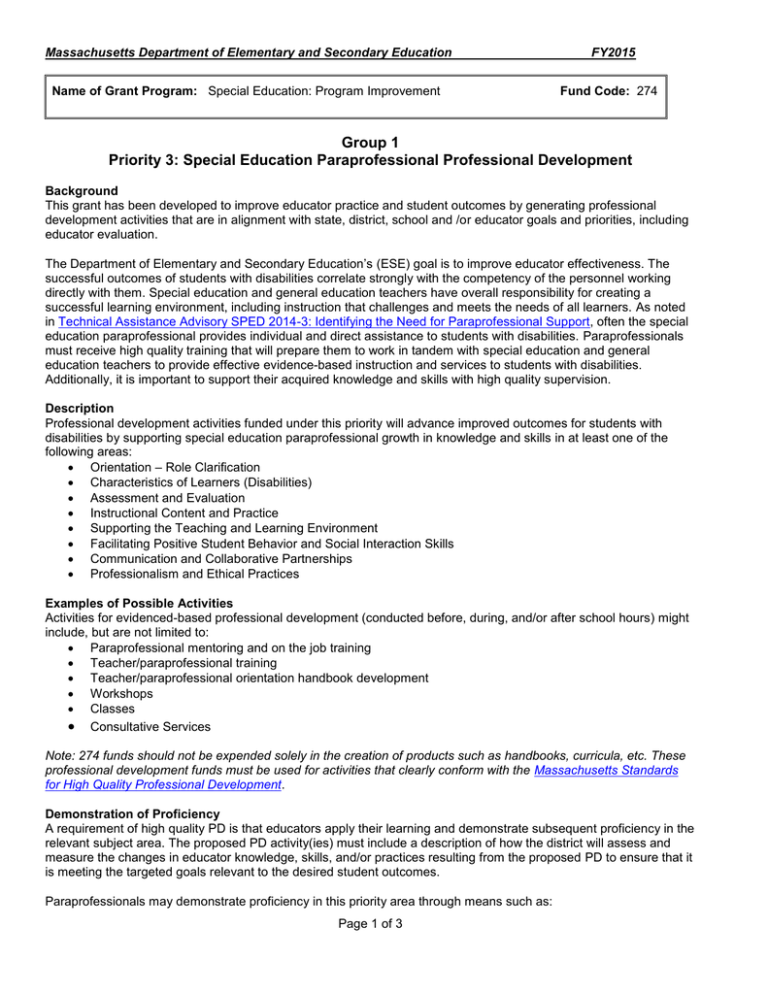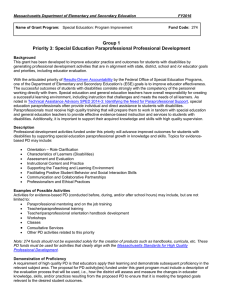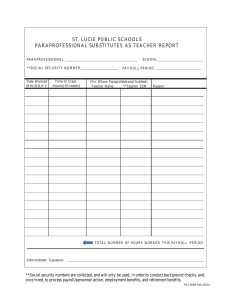PartIIIa Group1Priority3
advertisement

Massachusetts Department of Elementary and Secondary Education Name of Grant Program: Special Education: Program Improvement FY2015 Fund Code: 274 Group 1 Priority 3: Special Education Paraprofessional Professional Development Background This grant has been developed to improve educator practice and student outcomes by generating professional development activities that are in alignment with state, district, school and /or educator goals and priorities, including educator evaluation. The Department of Elementary and Secondary Education’s (ESE) goal is to improve educator effectiveness. The successful outcomes of students with disabilities correlate strongly with the competency of the personnel working directly with them. Special education and general education teachers have overall responsibility for creating a successful learning environment, including instruction that challenges and meets the needs of all learners. As noted in Technical Assistance Advisory SPED 2014-3: Identifying the Need for Paraprofessional Support, often the special education paraprofessional provides individual and direct assistance to students with disabilities. Paraprofessionals must receive high quality training that will prepare them to work in tandem with special education and general education teachers to provide effective evidence-based instruction and services to students with disabilities. Additionally, it is important to support their acquired knowledge and skills with high quality supervision. Description Professional development activities funded under this priority will advance improved outcomes for students with disabilities by supporting special education paraprofessional growth in knowledge and skills in at least one of the following areas: Orientation – Role Clarification Characteristics of Learners (Disabilities) Assessment and Evaluation Instructional Content and Practice Supporting the Teaching and Learning Environment Facilitating Positive Student Behavior and Social Interaction Skills Communication and Collaborative Partnerships Professionalism and Ethical Practices Examples of Possible Activities Activities for evidenced-based professional development (conducted before, during, and/or after school hours) might include, but are not limited to: Paraprofessional mentoring and on the job training Teacher/paraprofessional training Teacher/paraprofessional orientation handbook development Workshops Classes Consultative Services Note: 274 funds should not be expended solely in the creation of products such as handbooks, curricula, etc. These professional development funds must be used for activities that clearly conform with the Massachusetts Standards for High Quality Professional Development. Demonstration of Proficiency A requirement of high quality PD is that educators apply their learning and demonstrate subsequent proficiency in the relevant subject area. The proposed PD activity(ies) must include a description of how the district will assess and measure the changes in educator knowledge, skills, and/or practices resulting from the proposed PD to ensure that it is meeting the targeted goals relevant to the desired student outcomes. Paraprofessionals may demonstrate proficiency in this priority area through means such as: Page 1 of 3 Classroom observations Paraprofessional surveys Teacher/mentor surveys Exhibiting student support academically, socially, and/or emotionally Sharing knowledge of paraprofessional handbook content Exhibiting effective educator collaboration In order to better disseminate promising practices statewide, ESE may request that districts share products and outcomes resulting from this PD. Networking ESE may offer districts the opportunity to attend one or more statewide networking meetings in 2014-2015 around this priority. These meetings may include opportunities for collaboration, the sharing of best practices, and focused training in the above priority area. More information about these meetings will be announced in the fall of 2014. OVERVIEW OF FUND CODE 274 NARRATIVE REQUIREMENTS Professional Development Assurances Statement A. Overview: Please select one of the following FY2015 priorities. All professional development (PD) in this application must align with the selected priority below. 1. Which priority will the proposed PD address? 2. Choose the topic(s) that best aligns with the proposed professional development. B. Propose activities to be funded through the 274 grant: 1. Identify and briefly describe the proposed PD activity(ies). 2. Identify the goals and objectives for the proposed PD. Note: Goals/objectives must target improvement in educator practice and demonstrate a relationship to student outcomes. a. SMART Goal – Learning outcomes for students with disabilities (Smart Goal Definition: Specific and strategic; measurable; action-oriented; rigorous, realistic, results-focused; timed/tracked) b. SMART Goal – Learning outcomes for Educators (Smart Goal Definition: Specific and strategic; measurable; action-oriented; rigorous, realistic, results-focused; timed/tracked) c. Does the proposed PD support any state, district, school, and/or educator goals or priorities? Please Explain. 3. For each activity, provide a proposed timeline, including the number of contact hours and the name(s) of provider(s). Note: If you are proposing individualized, rather than school or district-wide PD and have yet to identify a provider(s), please describe the type of provider you will be seeking and how you will ensure that the selected professional development will be aligned with the above priority and contribute to district professional development goals. 4. Describe the job embedded activities or plans for participants to apply their learning to the particular content and/or context. 5. Identify the professional role(s) of targeted participants District Level Administrators Special Education Teachers Principals Parents Teachers Paraprofessionals Related Service Providers Other____________________ Page 2 of 3 C. Data-based Rationale for PD Activities: 1. What data did you analyze that led you to this proposed PD? IDEA Part B State Performance Indicator Data IDEA Part B Determination Level Data Performance Data MCAS Results Teacher Surveys Conditions for School Effectiveness Data School Safety Discipline Report Other____________________ 2. Based on the data you analyzed, what is the rationale for the proposed PD? D. Outcomes and Evaluation: How will you assess and measure the changes in educator knowledge, skills, and/or practices resulting from the proposed PD to ensure that it is meeting the targeted goals relevant to the desired student outcomes? Page 3 of 3





